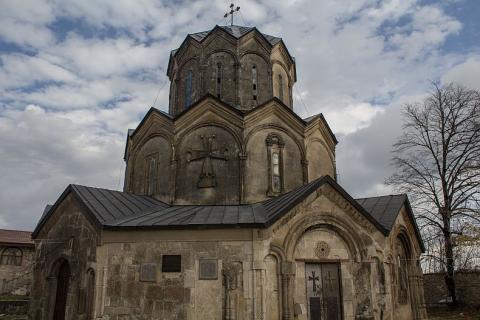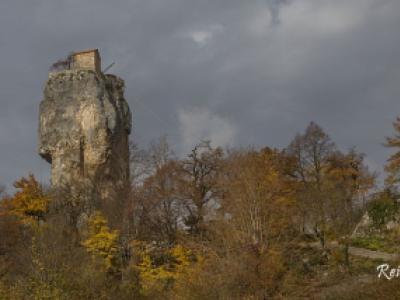Don't be surprised of the name Katskhi, this is a church located some 2km from the famous Katskhi pillar in Georgia.
The Katskhi Monastery of Nativity of the Savior, more commonly known as the Katskhi Monastery is a medieval monastery in Georgia, located in the village of Katskhi near the town of Chiatura. It was built at the behest of the Baguashi family in the period of 988–1014. The church building is noted for a hexagonal design and rich ornamentation. Closed down by the Soviet government in 1924, the monastery was revived in 1990 and is now operated by the Eparchy of Sachkhere and Chiatura of the Georgian Orthodox Church.

Katskhi church
The Katskhi monastery is a octagonal building of more complex design than other similar polygonal Georgian monuments such as Gogiuba, Kiagmis-alty, Oltisi, and Bochorma. The exterior of the church features three gradually narrowing cylindrical levels formed by the faceted gallery, the main body of the church, and the drum of the dome.
The six apses are inscribed into the outer polyhedron and surrounded by an ambulatory from all sides. An inscription from the ambulatory mentions the certain "Tskhovreba, daughter of Ioann, Duke of Dukes". A single spacious interior compartment around the subdome bay includes radially oriented semi-circular apses. One of these, the altar apse, projects outward prominently due to its large bema. The drum of the dome is also faceted. Each facet of the main body of the church as well as that of the dome and gallery terminate in a pediment with three lines of polygonal cornices.
The building was richly ornated, but the decoration of two upper tiers was lost in the process of the 1854 restoration. Of note is a large composition in relief at the southern vestibule of the gallery, the Exaltation of the Holy Cross, featuring a cross supported by four angels.
The church is surrounded by a pentagonal wall, which contains a free-standing bell tower in its eastern corner. These structures are later additions, probably from the 17th or 18th century.

